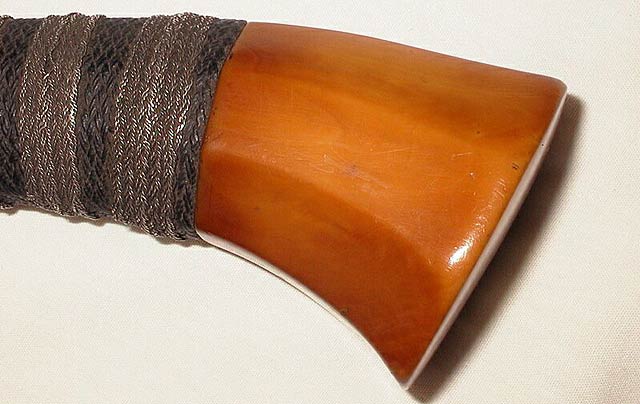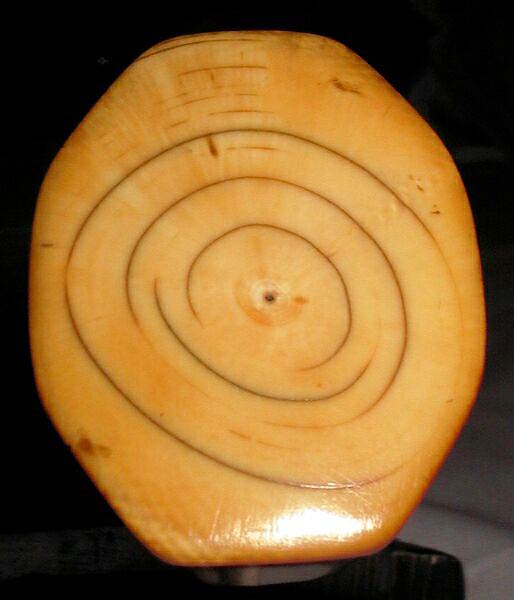
 |
|
|
#31 |
|
Member
Join Date: Apr 2006
Posts: 10
|
Hay caramba!
I never expected that this sword was that complecated! But its a good learning experience. |
|
|

|
|
|
#32 |
|
Vikingsword Staff
Join Date: Nov 2004
Posts: 6,339
|
Ernesto , believe me ; stick with the Chinese stuff !
These Moro swords are sooo boring ........  
|
|
|

|
|
|
#33 | |
|
Member
Join Date: Dec 2004
Posts: 221
|
Quote:
|
|
|
|

|
|
|
#34 | |
|
Member
Join Date: Dec 2004
Location: Cincinnati, OH
Posts: 940
|
Quote:
 ....just sell that puppy to me and you'll sleep much better. ....just sell that puppy to me and you'll sleep much better. 
|
|
|
|

|
|
|
#35 |
|
Member
Join Date: Jan 2005
Location: Kansas City, MO USA
Posts: 312
|
Hey Rick......
Don't forget me! For you, I will beat anyones offer by a dollar.    But don't let nechesh know. 
|
|
|

|
|
|
#36 | |
|
Member
Join Date: Jan 2006
Posts: 50
|
Quote:
I second to that, Rick! in case Nechesh here pass that opportunity! You can email me direct any time, and I promise, I'll take care of it really good. Btw, I'll show it to him once in a while like you do 
Last edited by panday; 20th April 2006 at 08:34 PM. |
|
|
|

|
|
|
#37 |
|
Vikingsword Staff
Join Date: Nov 2004
Posts: 6,339
|
HEY !!
Take it to Swap you guys (I won't be there) LOLZ ....  Now back to our regularly scheduled programming ; anyone besides me think the the pommel on the original subject kris may not be elephant ivory ? |
|
|

|
|
|
#38 |
|
EAAF Staff
Join Date: Dec 2004
Location: Louisville, KY
Posts: 7,280
|
Pinoy,
W  W! Thank you for showing this example - georgios kris. W! Thank you for showing this example - georgios kris. Rick, I think you have a good point. I was wondering this myself for the same reasons, and it was not unheard of to use hippo ivory. This might explain some of why this pommel is not larger than it is (elephant being larger tusk). |
|
|

|
|
|
#39 |
|
Vikingsword Staff
Join Date: Dec 2004
Location: The Aussie Bush
Posts: 4,399
|
Pinoy:
Lovely color to the ivory -- rich golden, with a slight reddish hue. Could this be dugong ivory? There is an example in Cato that he calls Sea cow (dugong),* and some time ago we had a discussion about dugong ivory on the old forum. Ian. Robert Cato. Moro Swords. Graham Bush Ltd: Singapore, 1996, Figure 42, p. 69 Last edited by Ian; 22nd April 2006 at 04:27 AM. |
|
|

|
|
|
#40 | |
|
Member
Join Date: Jan 2006
Posts: 50
|
Quote:
Couldn't sleep last night due to jetlag from long flight, so I start carving a scabbard for it (from an extra Maguindanoan scabbard of mine) just for protection. Last edited by panday; 22nd April 2006 at 05:12 AM. |
|
|
|

|
|
|
#41 |
|
Vikingsword Staff
Join Date: Nov 2004
Posts: 6,339
|
Do you see any kind of a cross hatched pattern in the grain ?
|
|
|

|
|
|
#42 | |
|
Member
Join Date: Jan 2006
Posts: 50
|
Quote:
|
|
|
|

|
|
|
#43 | |
|
Member
Join Date: Jan 2006
Posts: 50
|
Quote:
I had mine polished, but didn't change a thing. I thought ivory as it gets older they turn to light golden/yellow, like the aged pool cue balls, this ones are just dark orange. Tea stained? Last edited by panday; 22nd April 2006 at 04:54 AM. |
|
|
|

|
|
|
#44 |
|
Vikingsword Staff
Join Date: Dec 2004
Location: The Aussie Bush
Posts: 4,399
|
The depth of color seems to vary a lot, but in general I think ivory gets darker with age and handling. I have several old ivory-hilted dha from Burma and Thailand that have ivory that is quite dark, almost as though it has been smoked.
I think that body oils (grease) get transferred during handling and carrying and this is mainly responsible for the color change. Add a little dirt (as seen in the fine cracks) and we end up with the familiar look of old ivory. Dugong (sea cow, manatee) ivory has a distinct reddish hue to it. I've now seen several illustrated examples and I believe that I own a kris with dugong ivory (at least it was sold to me as dugong ivory by a Filipino dealer in Manila whom I have dealt with for many years, and it matches the color of the dugong hilt in Cato). Ian. Here are pictures of that hilt.  
|
|
|

|
|
|
#45 |
|
Member
Join Date: Jan 2006
Posts: 50
|
Dugong (sea cow, manatee) ivory has a distinct reddish hue to it. I've now seen several illustrated examples and I believe that I own a kris with dugong ivory (at least it was sold to me as dugong ivory by a Filipino dealer in Manila whom I have dealt with for many years, and it matches the color of the dugong hilt in Cato).
Stellar sea cow/manatee/dugong raw material. |
|
|

|
|
|
#46 | |
|
Vikingsword Staff
Join Date: Nov 2004
Posts: 6,339
|
Quote:
 Panday , that Sea Cow ivory looks very porous in cross section . Interesting ..... Rick |
|
|
|

|
|
|
#47 |
|
Member
Join Date: Dec 2004
Posts: 1,018
|
Punal, good catch on that Kris. Congrats.
I believe the Seacow Ivory are the ribs that's why it's so porous. I have seen them for sale at Knife shows. |
|
|

|
|
|
#48 | |
|
Vikingsword Staff
Join Date: Nov 2004
Posts: 6,339
|
Quote:
So this would then be fossil material ? |
|
|
|

|
|
|
#49 |
|
Member
Join Date: Dec 2004
Posts: 1,018
|
Rick, It is indeed fossil material. The seller informed me that he obtains
some from Alaska and the Siberian tundra. They're beautiful polished. |
|
|

|
|
|
#50 | |
|
Vikingsword Staff
Join Date: Dec 2004
Location: The Aussie Bush
Posts: 4,399
|
Rick:
I think this may be an artefact of how I manipulated the image in Photoshop. Sometimes using the "sharpen" tool can create distortion and bring out patterns that aren't really there. The cross hatching is not visible in the original image. The concentric rings and central vein suggest that this example is a tusk (tooth) rather than a rib. Ian. Quote:
|
|
|
|

|
|
|
#51 |
|
Member
Join Date: Dec 2004
Location: New Jersey
Posts: 134
|
Rick,
I believe they are called ossic. |
|
|

|
|
|
#52 |
|
Member
Join Date: Dec 2004
Posts: 1,018
|
Ibeam, Oosik is below the ribs on the body, for humans. Only males have oosik's. Do you know what I mean. Living up here in the PNW, I see a few numbers for sale at curio shops. LOL
|
|
|

|
|
|
#53 | |
|
Member
Join Date: Jan 2006
Posts: 50
|
Quote:
Hi there Ibeam, long time no talk! Oosik are walrus' male genital organ and they are also perfect as knive scales, handles, and others, it can also be carved and polished to sheen like ivory. Example of Walrus oosik baculum and a Damascus fighting bowie knife with oosik handle. Last edited by panday; 23rd April 2006 at 02:23 AM. |
|
|
|

|
|
|
#54 |
|
Member
Join Date: Jan 2006
Posts: 50
|
I believe the Seacow Ivory are the ribs that's why it's so porous. I have seen them for sale at Knife shows.[/QUOTE]
Kino, You are absolutely right, this are sea cow ribs and most were fossilized, the ones that I have, are not(Stellar peices). I have contacted several sellers and asked them if there was really a sea cow ivory and all of them gave the same answer! sea cow bone, is ivory, sea cow tusk? Question, the sea cow ivory on Cato's book, is that a bone or tusk? Last edited by panday; 22nd April 2006 at 11:42 PM. |
|
|

|
|
|
#55 | |
|
Vikingsword Staff
Join Date: Dec 2004
Location: The Aussie Bush
Posts: 4,399
|
Quote:
Ian. |
|
|
|

|
|
|
#56 |
|
Member
Join Date: Jan 2006
Posts: 50
|
Another example of a very raw material.
Sea cow/Dugong/Manatee Skeleton (stellar's collection) |
|
|

|
|
|
#57 |
|
Member
Join Date: Dec 2004
Location: New Jersey
Posts: 134
|
Thank you Kino (long time no talk!..
 .. ) & Panday for the info, .. ) & Panday for the info,I knew what part oosic was but never seen polished or finished walrus rib bone.  Oosic looks very similar to Panday's pictures of rib bones in the box. Oosic looks very similar to Panday's pictures of rib bones in the box.
|
|
|

|
|
|
#58 | |
|
Member
Join Date: Dec 2004
Posts: 221
|
Quote:
"Rajah Balatamay's story is one of the finest in the glorious years of the sultanates. Balatamay, who was from Buayan (Cotabato Upriver Valley) and Maguindanao (then comprising most of Mindanao), was exiled to Sulu after he killed Spanish Ambassador Melchor Lopez, a co-signatory of Sultan Kudarat to a Spain-Maguindanao Treaty ceding parts of Mindanao to Spanish claims on Islas Pilipinas in 1645. His close friend Wasit gave Balatamay the highest defense post of the Sulu sultanate and subsequently sent him to Brunei to lead the combined reinforcement of Maguindanao and Sulu. He was to help Brunei's Sultan Saiful Rijal quell a rebellion mounted in his kingdom by Visayan settlers. It was said that the triumphant defense of the Brunei sultanate prompted Rijal to reward the sultanate of Sulu with his government's property in North Borneo, the Sabah territory (which Malaysia, declaring independence from Britain, annexed in 1961), while the sultanate of Maguindanao was given a territory in Ternate in what is now Indonesia. *Blood evidence* Kudarat's annexation of Ternate having been rewarded his sultanate bears blood evidence in his descendants among the Diocolano family in Maguindanao, whose matriarch was the princess of Ternate. Returning to Sulu after almost two decades in the Brunei war, Balatamay learned that his father-in-law was determined to enthrone his child by the Sulu princess even if the child turned out to be a girl. Balatamay declined to anoint his young daughter to reign over Sulu as Pangian Ampay Putri Kabira after her grandfather. (Pangian is the feminine title equivalent to the masculine sultan). The son-in-law's opposition prompted the Sulu sultan to call for bloodshed in a gladiators' fight of sorts: should there be none to take the challenge of the sultan to fight his hardest fighting warrior, then it would become a one-on-one fight between the father-in-law and the son-in-law—a kind of only one wish, yours or mine, should prevail. Datu M'gkap of Buayan took up the cudgel for Balatamay and won over the Sulu warrior. But still, Balatmay submitted to his father-in-law, who still had ultimate power to decide over the affairs of Sulu. Some historians say the ascension to power of Pangian Ampay Putri Kabira remains an unresolved case to this day in the Sulu sultanate's council, the Ruma Bichara." |
|
|
|

|
 |
|
|